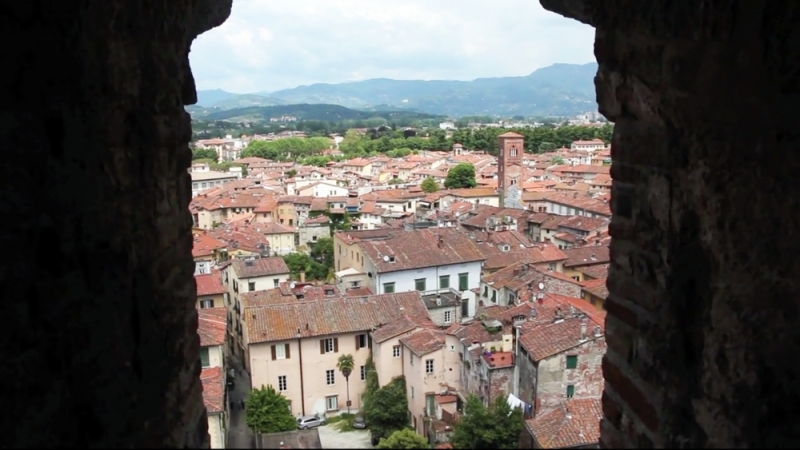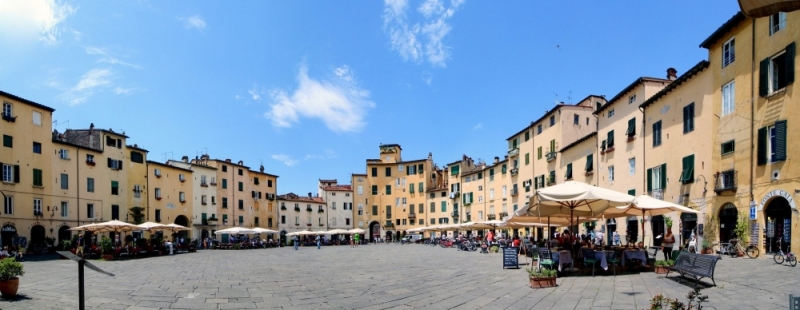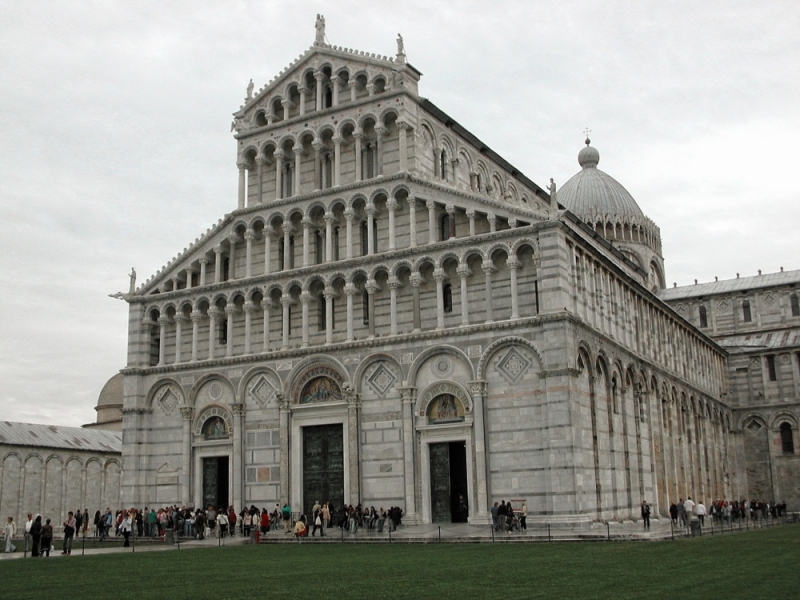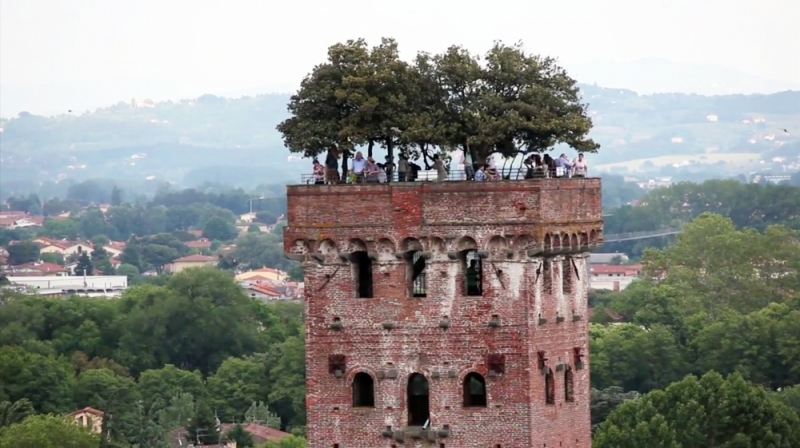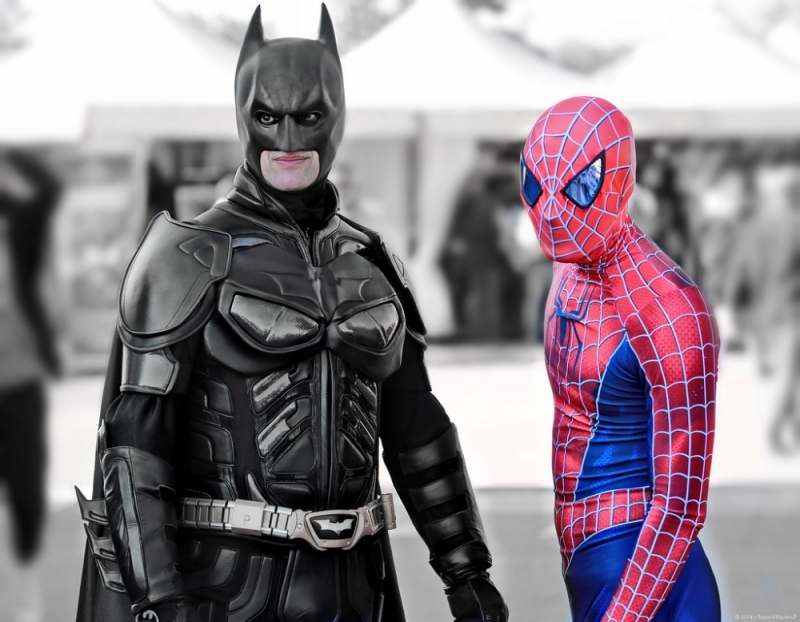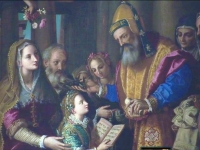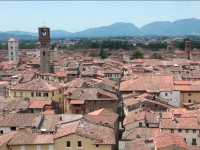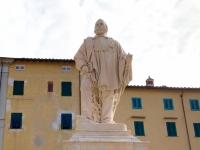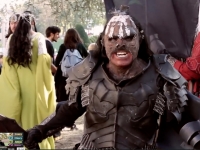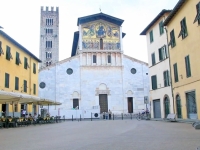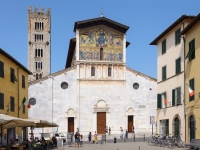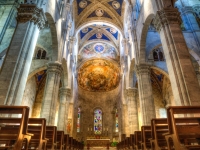Lucca and its origins
Lucca is an Italian municipality of approximately 88,824 inhabitants, and the capital of the province of the same name in Tuscany. A city rich in history and tradition, it has long been a place of trade thanks to its strategic position, but in its surroundings there are also numerous countryside in which elegant villas stand out, such as Villa Torrigiani and Villa Mansi. The city of Etruscan and even earlier Ligurian origins has a Roman origin and has been, throughout history, a city of merchants and weavers. Its name probably derives from a Celtic-Ligurian word, “Luck” which means “Place of Marshes”. Lucca had a prosperous period in the 6th century, with the Lombard domination. Following the death of Matilda of Canossa, the city became a free municipality in 1119 and was then governed by an oligarchic republic from 1369 to 1799, when Napoleon took it over, and then ceded it to his sister Elisa in 1808. Today inside of the walls, it is still possible to admire the city-state character that Lucca has preserved over time, with medieval houses and Renaissance palaces. In Lucca there are 100 churches, but those who love good food and shopping can also visit it. For many years the city has also been considered one of the most loved destinations by Americans. Of the Roman remains it is possible to admire the city walls, which have been transformed into numerous houses, which form the oval frame of Piazza Anfiteatro, home to aperitifs, shows and events. Most of the public and religious buildings date back to the 11th and 12th centuries, when the city had a flourishing economy, thanks also to its merchants and bankers. To date, some tower-houses are also visible, such as the Guinigi Tower and the Torre delle Ore.
What see
We advise you to start from the city walls and from San Pietro gate . You cannot say that you have actually visited Lucca without having visited the walls and the main access gates to the city, which are part of the UNESCO World Heritage Site. The construction of the walls began in 1500, to protect itself from the rival Florence and the Grand Duchy of Tuscany. The walls, about four kilometers long, are the second in Europe (after those of Cyprus), to have been built with modern fortification principles. There are six access doors to the historic center: Porta Santa Maria, Porta San Jacopo, Porta Elisa, Porta Sant'Anna, Porta San Donato and Porta San Pietro. Piazza Napoleone, also called Piazza Grande, is the heart of the city. Its origins date back to 1806, when the city was under siege of Napoleon's army and his sister, Elisa Bonaparte Baciocchi, decided to build the square by placing a statue dedicated to her brother in the center. It was after the Congress of Vienna in 1815 and the liberation of the city of Lucca from French troops that the square was restored by the architect Lorenzo Nottolini at the behest of Maria Luisa di Borbone, who in those years was appointed Duchess of Lucca.
Doge's Palace and Giglio Theater
Dominating the square is the Palazzo Ducale . It was also called Palazzo degli Illustrissimi Signori, Main Palace of the Serenissima Republic of Lucca, while today it is known as Palazzo della Provincia and has represented the political and administrative center of the city of Lucca for eight centuries since the architectural evolution of the building, it is linked to the political events of the Res Publica Lucensis. The palace was built on the foundations of the ancient 14th century Castruccio Castracani palace. The palace, as it currently appears, was rebuilt according to the architectural directions of the Florentine Bartolomeo Ammannati in 1578 and later revisited by Francesco Pini, a pupil of Filippo Juvarra, in Baroque style. Inside there are the Nottolini staircase, the gallery of statues, the General Council Hall, the Loggia dell'Ammannati and the Staff Room. In the square there is also the Teatro del Giglio , which has always been the cultural and artistic symbol of the city, which since 1985 has obtained the recognition of Theater of Tradition. Its construction dates back to more than three centuries ago, when the Council of the Republic of Lucca established a public theater. During the course of the nineteenth century the theater hosted well-known artists belonging to the Italian scene. It was Giacomo Puccini, well-known composer of the city, who participated in the realization of the staging of some of his works. Another artistic monument of the city is the art institute, always located in Piazza Napoleone.
Piazza dell'Anfiteatro Cathedral of San Martino
The current Piazza dell'Anfiteatro is a fantastic square in the city of Lucca, built by the architect Nottolini in 1830 and built on what was a wonderful and huge Roman amphitheater (similar to the coliseum) created at the time, to host shows and games with Arena. Its construction began in the first century AD with the emperor Claudius and ended during the Flavian age. The square today retains the elliptical shape of the amphitheater of the time and the medieval buildings that surround it were built largely with the stones, marbles and bricks of what was once the amphitheater. Near Piazza Napoleone, there is the Cathedral of San Martino , one of the oldest churches in Tuscany. Inside there is the Holy Face (an important relic symbol of the Catholic faith), the funeral monument to Ilaria del Carretto (by Jacopo della Quercia), the last supper by Tintoretto and various paintings by Ghirlandaio, by Fra ' Bartolomeo, Filippino Lippi and many others. The Cathedral probably dates back to the 6th century and it is assumed that it was built at the behest of San Frediano, the Irish monk patron saint of Lucca, in honor of which the Basilica of San Frediano was also built. Continuing there is the Church Santa Maria Forisportam , an Italian treasure dating back to the thirteenth century, in the Romanesque-Pisan style, which houses significant works by Guercino inside.
Church of San Michele in Foro - Duomo - Basilica of San Frediano -
In the center of the city, there is the Church of San Michele in Foro , with ancient origins, probably dating back to a period before 795 and representing a fusion of styles, ranging from Roman to Gothic. The Duomo , on the other hand, is located close to the walls of Lucca, on the opposite side of the city from the Basilica. Inside the church, there is the Madonna and Child, by Andrea della Robbia and a panel by Filippino Lippi which represents Saints Jerome Sebastian, Rocco and Elena empress. Another church representing the fusion of the Pisan-Roman-Lombard styles is the Basilica of San Frediano , dating back to the XII century and built in honor of the patron saint of Lucca, with a suggestive mosaic on the facade that symbolizes ascension. Inside there is the tomb of Santa Zita, where its mummified body is kept. As Lucca is known as a city of 100 churches, there are numerous other churches to visit, including the Church of Saints Giovanni and Reparata , between Piazza Napoleone and Piazza San Martino, dating back to the 4th century which today is also home to a museum. The current museum shows the different historical stratifications of the church. The Church of Santa Maria della Rosa , built in 1309, to honor Santa Gemma is also suggestive. Over time the church became an oratory where the image of the Madonna between Saints Peter and Paul was venerated. The historic center of the city has maintained its medieval appearance intact, as we have seen, thanks to its numerous churches, but also thanks to the towers, bell towers and Renaissance palaces.
Torre delle Ore Palazzo Mansi Museum of the Risorgimento
In the city, in the Middle Ages, there were 250 towers of which today two remain: the Torre delle Ore , approximately 50 meters high and Torre Giunigi, one of the monuments that symbolize the city. The latter was commissioned by the powerful family of Lucca merchants of the fifteenth century. It is 45 meters high and has a wonderful hanging garden on top, on which beautiful holm oaks grow. The tower of the hours, however, has a clock that still works with manual winding and from above it will allow you to enjoy the view of the city. Torre Giunigi , adjacent to the palace of the same name, is located on the corner of via Sant'Andrea and via delle Chiavi D'Oro. It rises 44.25 meters and to reach the top you have to walk well from 25 flights of stairs (not easy in the last where small metal ramps are located) for a total of 230 steps ... definitely a good workout before lunch. From the top you can admire the city center and the beautiful landscape of the surrounding mountains. Among the most beautiful museums in the city, there is the Mansi Palace , purchased and renovated in the seventeenth century by the Mansi family, once it became their residence. It was then decorated in Baroque style, with frescoes that represented the magnanimity of the family, until it became a museum in 1977. The Risorgimento Museum , was born as a War Museum and closed in '45 when its finds were abandoned in a warehouse. The material was recovered in the late 1980s, thanks to Maurizio Baldini and ANCR (National Association of Combatants and Veterans). The Entry Point Via Francigena museum , also known as Casa del Boia, offers various contents, both interactive and audiovisual, which will describe the via Francigena, Lucca and its history. Not to be missed, before leaving the city, is the botanical garden . Founded in 1820 by Maria Luisa di Borbone, Duchess of Lucca, it houses several collections of plants, which will leave you breathless.
Entertainment
Since the walls are one of the main symbols of the city, we advise you to take a walk between the ramparts and the city walls, before leaving. The nightlife is concentrated especially in Piazza Anfiteatro, Piazza San Michele and via Fillungo. You can also take a tour of Montecarlo, going through the various stages of its history, from 1332 to the present day or discover the finds of the Roman Lucca, the city of Piatrasanta, see the fortress of Montalfonso, take a tour of monasteries and convents or stroll on the Devil's bridge. If you feel hungry after walking, you can have a happy hour at the Betty Blue café in the center of Lucca or stop by Il Baccanale. For wine lovers there is Vinarkia della Pavona, a characteristic wine shop with different varieties of wines. In addition to the architectural beauties, Lucca also has a deep-rooted culinary tradition, which includes soups (such as farinata), polenta (for example the mastuffo) and tordelli, tortelloni stuffed with beef, pork and bread softened in broth. Typical restaurants include La Bottega dell'Oste, Tana del Boia and Antica Locanda dell'Angelo. If you are in Lucca between late October and early November, Piazza Grande is the home of the Lucca Comics event and in July of the Summer Festival, which brings the best of Italian and international rock-pop music to the city. "Il Desco" is held at the end of November and beginning of December within the Royal College, the most anticipated market exhibition for lovers of high quality typical products, with the display and sale of typical products from Lucca and Tuscany.
Climate, curiosity and advice
Climate: Lucca's climate is Mediterranean, with mild and rainy winters and hot and sunny summers. The coldest month is January, with an average temperature of 7.8 ° C, while the hottest is July, with an average temperature of 25.3 ° C. The rainiest month is November, while the least rainy month is July. The most suitable months to visit the city are May and September.
Curiosity: one of the most loved symbols of the city of Lucca is the Holy Face. According to an ancient legend, the Holy Face arrived in Lucca in 742 and, to date, it is located in the Cathedral of San Martino in Lucca. It is a wooden crucifix of particular workmanship, which would depict the face of Christ, which had considerable success in the Middle Ages, so much so that it was mentioned by Dante in the Divine Comedy. It is believed that he was the architect of many miracles that occurred in the city of Lucca. According to numerous critics, the current cross represents a copy of the original image, which was probably damaged to such an extent that it was replaced.
Tips: after getting lost among the ancient city walls and the medieval streets, we advise you to give yourself a stop in via Fillungo, the course of the “struscio”, where the commercial life once took place. Many historic shops have been closed, but you can stroll through the many boutiques and enjoy the unchanged atmosphere of the past.


